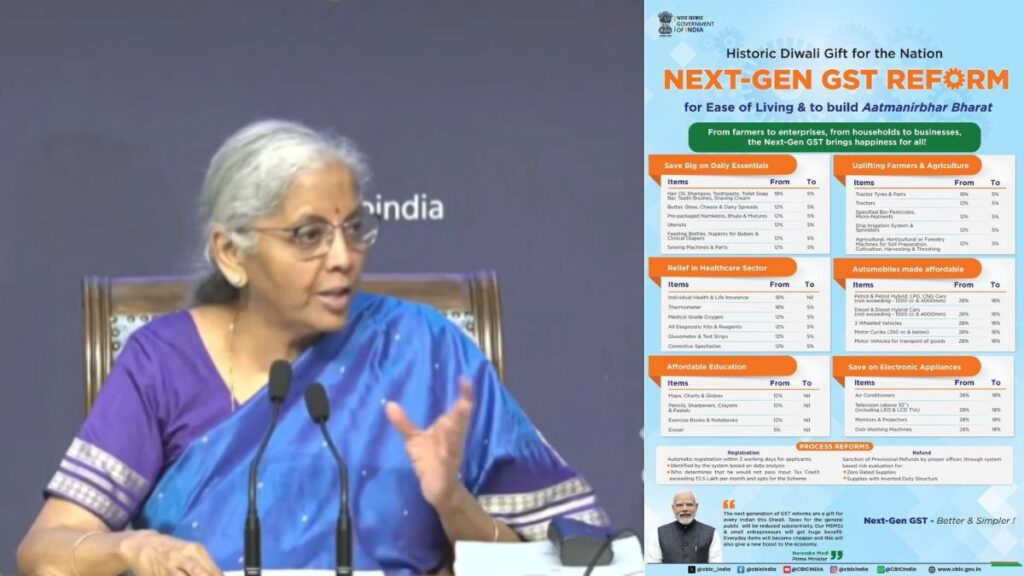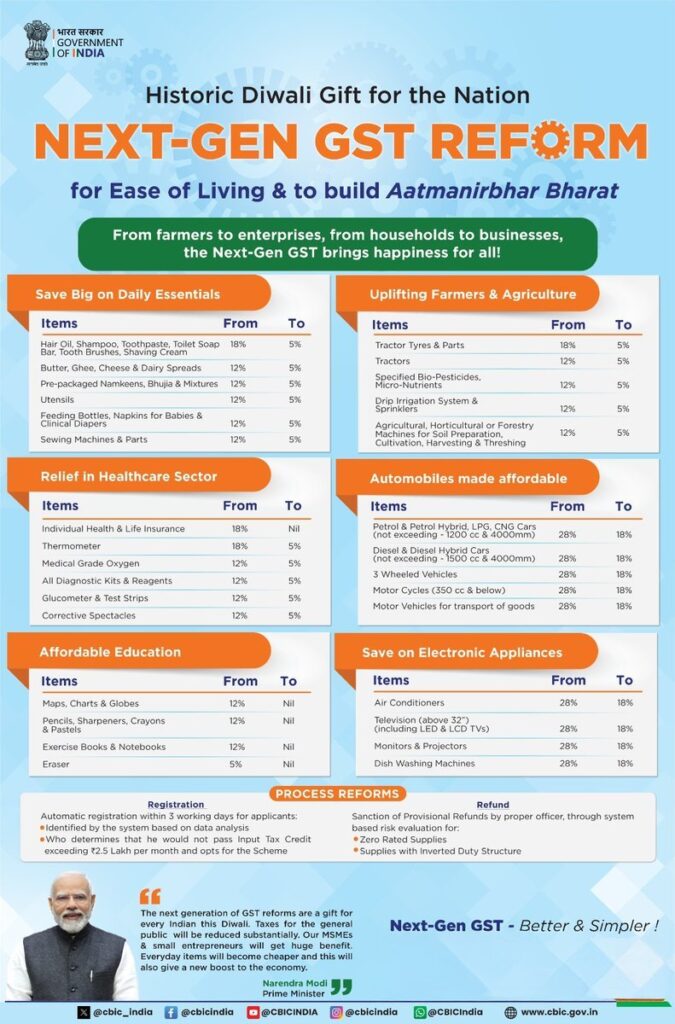GST Reforms Simplified: Know What’s Tax-Free, What’s Cheaper, and What’s Super Expensive Now

The Goods and Services Tax (GST) Council has approved one of the most sweeping reforms since the tax was introduced in 2017. At its 56th meeting in New Delhi, chaired by Union Finance Minister Nirmala Sitharaman, the Council cleared a host of tax cuts and structural changes designed to ease the burden on households and farmers, while stimulating industries and trade.
Prime Minister Narendra Modi, who had announced “next-generation GST reforms” in his Independence Day speech this year, described them as a citizen-centric overhaul to improve everyday life and make doing business simpler.
A Simpler Tax System
The four-tier GST structure will now be replaced by a simplified system with just two main rates:
- Standard Rate: 18%
- Merit Rate: 5%
- De-merit Rate: 40% (for select luxury and harmful goods)
What Goes to NIL Tax
Several essentials and critical items will now become completely tax-free:
- Food: UHT milk, packaged paneer, all Indian breads (roti, chapati, paratha, parotta).
- Healthcare: 33 lifesaving medicines (from 12% to NIL) and 3 drugs for cancer, rare diseases, and severe chronic illnesses (from 5% to NIL).
- Insurance: All individual life insurance policies and all health insurance policies (including senior citizen and family floater plans).
This means lower monthly household bills and reduced medical costs for millions.
What Gets Cheaper with Reduced Tax
A wide range of items will now attract lower GST:
- Everyday household items: Hair oil, soaps, shampoos, toothbrushes, toothpaste, bicycles, tableware, and kitchenware (down to 5%).
- Packaged food: Namkeens, bhujia, sauces, pasta, noodles, chocolates, coffee, preserved meat, cornflakes, butter, ghee (12%/18% to 5%).
- Electronics & appliances: TVs (all sizes), ACs, dishwashers (28% to 18%).
- Vehicles: Small cars and two-wheelers up to 350cc (28% to 18%), buses, trucks, ambulances (28% to 18%), three-wheelers (28% to 18%), auto parts now at a uniform 18%.
- Cement: Down from 28% to 18%.
- Healthcare equipment: Glucometers, bandages, diagnostic kits, surgical devices (12%/18% to 5%).
- Agricultural machinery: Tractors, harvesters, threshing machines, fodder balers, composting machines (12% to 5%).
- Labour-intensive goods: Handicrafts, marble, granite blocks, intermediate leather goods (12% to 5%).
- Fertilisers: Sulphuric acid, nitric acid, ammonia (18% to 5%).
- Renewable energy: Devices and parts for manufacturing (12% to 5%).
- Hotels & services: Hotel stays below ₹7,500 (12% to 5%), wellness services like gyms, salons, barbers, and yoga centres (18% to 5%).
- Other medicines: All other drugs reduced from 12% to 5%.
What Gets the 40% De-Merit Rate
To discourage consumption of harmful goods, a 40% GST slab will now apply to:
- Pan masala
- Gutkha
- Cigarettes
- Chewing tobacco (like zarda)
- Unmanufactured tobacco and bidis
These goods will also continue to attract compensation cess until cess-related obligations are cleared.
To understand the exact GST changes on a particular product category, click here to read the detailed press release by Ministry of Finance, Government of India.

Institutional and Legal Reforms
The Council has also approved the operationalisation of the Goods and Services Tax Appellate Tribunal (GSTAT). It will start accepting appeals by the end of September 2025 and begin hearings in December. This aims to speed up dispute resolution and provide greater clarity for taxpayers.
Implementation Timeline
The new rates on goods and services will be rolled out from 22 September 2025. Tobacco and related products will retain old rates until cess obligations are discharged.
What It Means for You
For households, groceries, medicines, and personal care will become cheaper. Farmers will save on machinery and fertilisers. Families will benefit from tax-free health and life insurance. Industries like textiles, cement, automobiles, and renewable energy will see a drop in costs, spurring demand and growth.
A Historic Reset
By simplifying the tax system and cutting rates on essentials, these GST reforms are being hailed as a historic step. They balance affordability for the common man with incentives for industry, marking a significant reset in India’s indirect tax regime.








